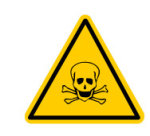
bleach
It whitens your whites, sanitizes your sinks and obliterates mold and mildew like friggin' Optimus Prime.
The stuff is amazing.
Crappy Chlorine
But those fluffy white towels and disinfected counters have a downside: one sniff and you might faint. Besides making you light-headed, that heavenly bleach scent is a sign you're dealing with a serious toxin. Chlorine bleach is a known respiratory irritant that can give off a toxic gas when it's mixed with other common household products. Fun fact? It was actually the first poison gas to be used as a weapon during World War I.
And you're wiping down your counters with this stuff?
What's in Your Tub?
These days, the biggest problem with chlorine is that its byproducts pollute our water supply and our bodies. Dioxins - a set of chemical chlorine byproducts - are considered the most carcinogenic little dudes known to science. Dirty dioxins accumulate in our fatty tissues and -- unlike other environmental toxins -- our bodies aren't able to metabolize them. So they stay in our systems and mess stuff up. In humans, dioxins have been linked to cancer, diabetes, hormonal imbalances, reproductive disorders, decreased fertility, endometriosis, birth defects and immune system problems.

safe
Dioxins are also hormone disrupters that mimic estrogen. On average, Americans ingest 300 to 600 times the EPA's "safe dose" of dioxins on a daily basis. The problem is so widespread that experts agree it would be difficult to find a person alive who does not have detectable levels of dioxins in his or her blood.
Scared yet? You should be. This stuff is nasty and it's kind of hard to avoid. Bleach is used to make paper products, including coffee filters, milk cartons, diapers, tampons, paper towels and toilet tissues. All of these products leech chlorine and dioxins into your drinks or onto your skin.
Bleach and Kiddies
If you have tots running around the house, it's especially important to ditch the bleach. A 1997 study found that one-third of calls to the Poison Control Center about household cleaners were about chlorine bleach - and most of those calls were about poisoning in children under 6 years old.
Safe Solutions
The good news? You don't have to clean like your mom did. Today, the chemical industry has evolved to produce products that still clean, sanitize and disinfect, without the harmful repercussions to our bodies and the environment:

bleach
Biokleen Oxygen Bleach Plus. This is a powder that uses grapefruit seed extract to brighten colors and whites. Fights stains, mildew and corrosion. Great for laundry and especially good at removing pet stains from carpets. Biodegradable and not tested on animals. PETA approved. $6 at biokleen.com or Whole Foods.

oxo

bleach ultra
Ecover Non-Chlorine Bleach Ultra. Contains only hydrogen peroxide and water. Not tested on animals. Good for removing stains, whitening and brightening laundry or for cleaning kitchen sinks, bathroom tile, showers, toilets and tubs. Safe for septic tanks. $5 at luckyvitamin.com or Whole Foods.
The Verdict
Pros: Removes stains and cleans without the harmful side effects of chlorine bleach. No nasty smells. Products are also more concentrated, meaning they're cheaper and use less packaging -- always a plus for the environment.
Cons: Laundry needs to be soaked longer than with chlorine bleach.
Want to know the deets on what else to buy? Click here to browse through our green, non-toxic product recommendations on HealthyBitchDaily.com.
No comments:
Post a Comment